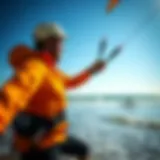Exploring the Depths of Wing Kitesurfing Techniques
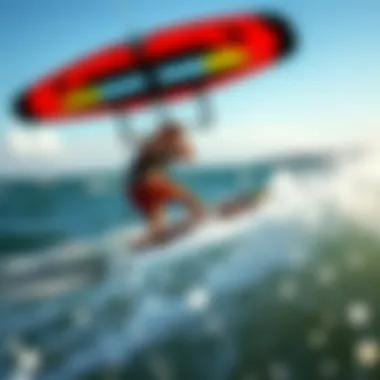
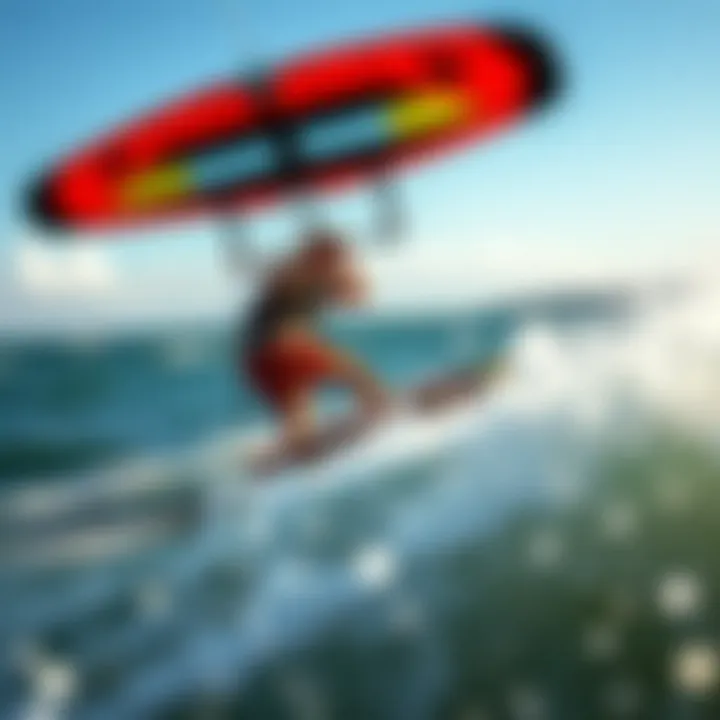
Gear Insights
Wing kitesurfing requires a unique set of gear that balances performance and comfort. As this sport evolves, so too does the equipment designed for it. Whether you're a seasoned pro or just starting out, understanding the latest gear helps optimize your time on the water.
Latest Gear Reviews
The market is saturated with options, so let’s break down some notable gear making waves lately. For example, the Duotone Echo has drawn attention for its lightweight design and smooth control. It performs admirably in varied wind conditions, allowing riders to feel the freedom of movement without feeling too tethered to their equipment. People rave about its stability, especially when attempting high-speed maneuvers.
Another noteworthy contender is the Naish S26 Wing, which has quickly gained popularity due to its durability and user-friendly nature. Riders often highlight the improved power delivery, making it a great choice for those venturing into both beginner and intermediate skill levels. Users appreciate that it doesn't require an engineering degree to understand its adjustments, making it a solid pick for newcomers.
Lastly, the Cabrinha Mantis has made quite a name for itself as well. Known for its responsive handling and versatility, this wing caters well to a variety of riding styles. From racing to freeriding, riders have expressed their satisfaction with the Mantis, noting that it rarely puts a foot wrong.
Essential Gear for Beginners
If you're new to wing kitesurfing, selecting the right gear is crucial. Here’s what to consider:
- Wings: Look for a size that offers stability, often around 4 to 6 meters for beginners, depending on your weight.
- Board: A wider, buoyant board is beneficial. A board around 5’ to 6’ with a decent volume helps maintain balance and support while learning.
- Safety Equipment: Having a personal flotation device and a proper helmet is non-negotiable. Safety first!
- Harness: A comfortable harness is essential for enjoyable kite sessions. The right fit allows for less fatigue and more control.
"Choosing the right gear is half the battle. It enhances your ability, making each session enjoyable and insightful."
While purchasing gear, consider local shops or online retailers with trusted reviews. Brand names aren’t always the final word; do your research. Sites like reddit.com can provide real-time feedback from other kitesurfers.
Techniques and Tips
In the world of wing kitesurfing, understanding the techniques is non-negotiable. Mastering these skills not only boosts your performance but also enhances your safety.
Advanced Tricks and Techniques
As you become comfortable on the water, pushing your limits becomes more enticing. Try integrating advanced moves like the Downloop turn and jump transitions. These techniques require deft control of your wings and a pronounced sense of balance. Riders often recommend practicing these tricks in lighter winds first, as they offer more control and less risk.
Engage in constant practice and when you eventually add speed, make sure you maintain a low center of gravity and don’t forget about your foot positioning. There’s no rush; mastering these elements constitutes the fabric of becoming a proficient rider.
Safety Practices for Kiteboarders
Safety is paramount, especially with the inherent risks of water sports. Here are essential practices to keep in mind:
- Awareness: Always be aware of your surroundings, including the weather patterns and other water users.
- Equipment Check: Regularly inspect your gear. Worn out lines or damaged wings can lead to accidents.
- Buddy System: Whenever possible, ride with a partner. Having someone else around can help in emergencies and offers additional support.
For more detailed safety guidelines, checking organizations like uswatersports.com can be greatly beneficial.
As you immerse yourself into this thrilling discipline, remember that both the gear you choose and the techniques you employ play crucial roles in your overall experience. This sport embodies a journey of continuous learning, pushing boundaries, and respecting nature. The key is to enjoy each session while preserving the integrity of this vibrant community.
Preamble to Wing Kitesurfing
Wing kitesurfing stands at the intersection of adventure and innovation, redefining the way enthusiasts interact with wind and water. This emerging discipline is not only exhilarating but also accessible, attracting an ever-growing community of kiteboarders, adventurers, and thrill-seekers. Understanding wing kitesurfing is essential for anyone looking to deepen their skill set or connect more intimately with nature. The fusion of surfing dynamics and kite maneuverability creates a unique riding experience that sets it apart from traditional kiteboarding.
With its rise in popularity, wing kitesurfing presents numerous benefits. It opens up new avenues for riders to explore, allowing them to enjoy expansive waterways and diverse wind conditions. Additionally, it fosters a sense of community among participants, promoting shared experiences and learning opportunities while encouraging respect for the marine environment.
In this guide, we will dissect crucial elements such as origin stories and evolving techniques, all pertinent for both newcomers and seasoned riders eager to expand their repertoire. Understanding these foundational aspects will not only enhance one’s enjoyment on the water but also contribute to preserving the integrity of this captivating sport.
Defining Wing Kitesurfing
Wing kitesurfing is a relatively new water sport that involves riding on a board while holding onto a wing, which generates lift from the wind. This wing, resembling a small parachute or sail, is distinct in its design, allowing for more maneuverability compared to traditional kites. Riders can choose varying wind conditions to fly above the surface, utilizing the board's buoyancy combined with the wing’s lift.
The setup generally consists of three main components: the board, the wing, and the harness. Riders stand on the board, which can be adapted for different skills and water conditions, while holding the wing through a leash connected to a harness. The beauty of this sport is in its simplicity, making it easier to learn while being exhilarating to master.
Historical Context
The roots of wing kitesurfing can be traced back to innovations in both kiteboarding and windsurfing. The melding of techniques from these existing sports kickstarted the quest for a new form of rider experience. In fact, the very first wings were developed as an extension of existing kite technology, paving the way for the modern craftsmanship seen today.
As enthusiasts continued to experiment, brands began to innovate, leading to the development of lighter, more robust materials and streamlined designs that improved performance. The past decade witnessed the sport gaining traction, catching not just the eyes of riders but also sparking interest in equipment manufacturers.
In recent years, events and competitions popped up across the globe, solidifying wing kitesurfing’s place in the water sports community. As more riders take to the water, learning and sharing techniques through social media platforms, the growth of this sport shows no signs of slowing down. People from all walks of life now engage in wing kitesurfing, further enriching the culture surrounding it.
Essential Gear for Wing Kitesurfing
Getting into wing kitesurfing without the right gear is like going into battle without armor. The choice of equipment greatly impacts not just performance but also safety and enjoyment on the water. The gear serves as your lifeline, allowing you to harness the wind and ride the waves. Understanding each component is vital for every kiteboarder, instructor, traveler, adventurer, and hobbyist alike.
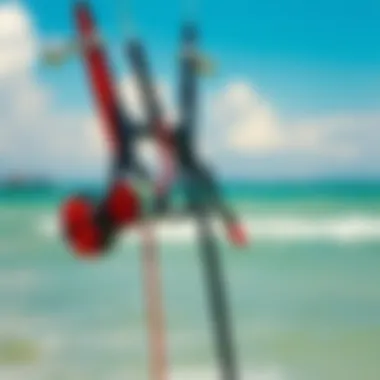
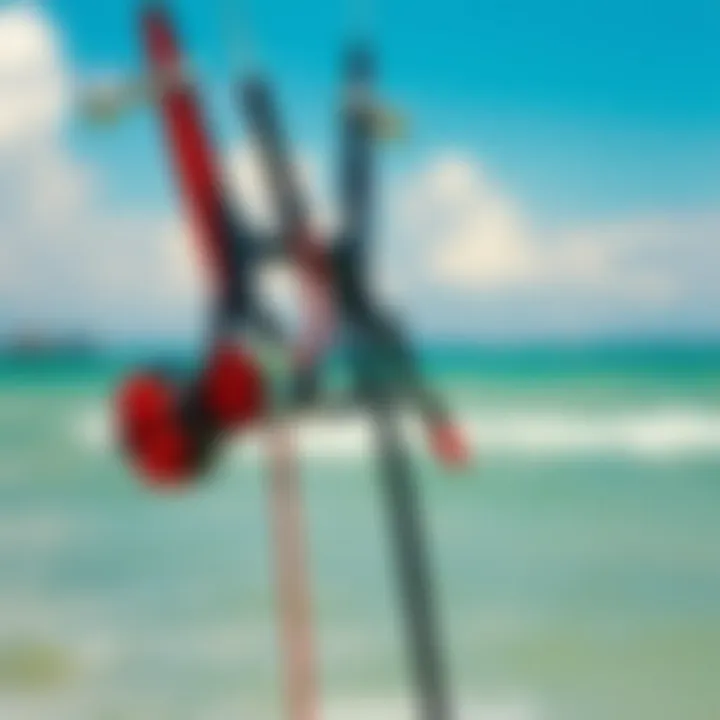
Wings: Types and Features
When discussing wings, it’s crucial to understand that they vary significantly in design and functionality to suit different styles and conditions. Essentially, wings are categorized into two primary types: inflatable wings and solid wings.
- Inflatable Wings: These are often the favorites among many beginners and casual riders. Constructed from durable materials, they rely on air for shape and support. An excellent example is the Duotone Echo, which is known for its ease of use and stability.
- Solid Wings: These wings tend to offer increased control and responsiveness, but they may take more time to master. Riders who often push their limits might opt for something like the SABFOIL Model.
Key features to consider while choosing a wing include size, weight, and aspect ratio. A larger surface area helps catch lighter winds, making it suitable for beginners. On the other hand, a smaller wing translates to quicker turns and higher speeds, appealing to those looking to perform tricks.
Boards: Design Variations
Having the right board can transform your riding experience, impacting stability and maneuverability while you’re out there harnessing the wind. Boards vary in design, and each type caters to specific riding styles.
- Twin-Tip Boards: Most common among beginners, these boards come with symmetrical designs allowing for easy riding in both directions. A notable choice is the Naish Hover, known for its forgiving nature on choppy waters.
- Directional Boards: Designed for more experienced riders, these boards are shaped to ride in one direction. They allow for better performance in surf conditions, and a popular option is the Slingshot Triad, which is applauded for its agility and wave-riding capabilities.
When selecting a board, consider factors like board length, width, and rocker profile. Longer boards often offer greater stability, while shorter ones are designed for speed and tricks.
Safety Equipment
Safety should never be an afterthought. In the hazy excitement of wing kitesurfing, it’s easy to overlook the importance of outfitting oneself with essential safety gear. At the very least, every rider should invest in the following:
- Personal Flotation Device (PFD): A good PFD is crucial for anyone hitting the water, providing buoyancy and protection.
- Helmet: Protecting your head is necessary, especially if you tend to push boundaries with aerial tricks. Brands like Pro-Tec offer well-ventilated, stylish options for both comfort and safety.
- Leashes: An often underestimated piece of gear, leashes keep the wing connected to you at all times. Look for a durable option that offers quick releases.
By prioritizing safety measures, you not only protect yourself but also create a safer environment for fellow kiteboarders around you.
"The ocean is a fickle mistress; equip yourself well to dance with her safely."
Techniques for Beginners
Wing kitesurfing, while thrilling, can also be a daunting task for newcomers. This section seeks to ingratiate the newcomer into the world of wing kitesurfing by focusing on the fundamental skills that set a strong foundation. Techniques learned during this phase can transform daunting challenges into exciting experiences. Getting the basics right improves performance, heightens enjoyment, and, perhaps most importantly, enhances safety.
Basic Handling Skills
Understanding how to handle the wing is the cornerstone of effective wing kitesurfing. It’s akin to learning how to hold a surfboard before tackling the waves. Here’s a breakdown of essential handling skills:
- Grip Techniques: Learning to properly grip the wing's handles is crucial. This not only provides more control but also minimizes the risk of losing the wing in the wind. Proper grip allows the rider to make quick adjustments.
- Wing Positioning: New riders must be cognizant of how to position the wing relative to wind direction. Keeping the wing at a 45-degree angle helps in generating lift without being overwhelmed.
- Body Stance: A stable body stance is key. Keeping knees slightly bent and your center of gravity low helps maintain balance. Corresponding body movements with wing positioning can create a fluid feel.
Practice Tip: Spend some time practicing steering the wing on land before hitting the water. Get comfortable with the movements while standing still; this drastically reduces the learning curve when you finally take off.
Launching and Landing
The launch and landing aspect of wing kitesurfing can be a make-or-break element for beginners. Successfully starting and stopping your session lays the groundwork for safety and confidence:
- Preparing for Launch: Check the wind conditions and ensure there’s no obstruction around. Position the wing on the ground, making sure it’s facing into the wind before taking hold of the handles. Also, ensure that the board is on the ground to prevent any missteps.
- Guiding the Wing: When launching, start with the wing low. Gradually pull one handle while slightly shifting your body weight to catch the wind beneath the wing.
- The Importance of Timing: It’s vital to time your launch correctly. Wait for the wind to fill the wing before attempting to stand. Mistimed launches can lead to falls or the wing getting away from you.
- Safe Landings: Just as launches require care, landings do too. Bring your wing down gently, keeping it steady and controlled. Lower it in front of you, and prepare to let it drift to the side out of your way.
“Successful launches and landings are about finesse, not force.”
Building Confidence on Water
Gaining confidence in the water can be a process akin to learning to walk before you run. This stage is essential as it bridges the gap between basic skills and more advanced maneuvers:
- Start Small: Begin by practicing straight rides on calm days with moderate winds. Getting familiar with how the wing stabilizes you in water is crucial to building confidence.
- Regular Practice: Consistency is key. The more time spent riding, the more familiar the body gets with the sensations of wing kitesurfing.
- Focus on Stability: Work on maintaining a steady speed. An unstable kite can create hesitation. Control while riding translates into success.
Building that confidence not only makes the learning process enjoyable but also enhances safety and prepares you for trickier maneuvers down the road.
In summary, beginners are better equipped to embrace wing kitesurfing after mastering these techniques. Understanding the handling skills, efficiently launching and landing, as well as fostering confidence on water, lays the groundwork for advanced exploration in the exciting realm of wing kitesurfing. These skills create the foundation for a journey filled with thrilling experiences, opportunities for community, and connection to nature.
For further reading and community support, consider exploring resources such as Wikipedia, Britannica, or Reddit.
Advanced Wing Kitesurfing Techniques
The realm of wing kitesurfing opens up a world of excitement that extends well beyond the basics. Once practitioners have mastered the fundamentals, diving into advanced techniques not only enhances their skill set, but also enriches their overall experience on the water. Mastering these skills allows riders to display their creativity and agility, pushing the boundaries of how wing kitesurfing can be enjoyed.
Transitions and Turns
Transitions and turns are often the backbone of dynamic wing kitesurfing performance. These maneuvers not only help maintain speed and momentum but also serve as a gateway to other advanced tricks. Understanding how to execute smooth transitions between riding directions is essential. The key lies in properly managing your weight distribution and kite positioning.
Steps for Smooth Transitions:
- Anticipate your move: Recognizing the right moment to change direction is crucial. Pay attention to your surroundings and the wind's behavior.
- Shift your weight: As you're preparing to turn, lean slightly toward the direction you want to transition into. This shift will help in guiding the board to follow through the turn.
- Adjust the wing position: During the transition, it’s essential to keep the wing angled correctly against the wind. A good rule of thumb is to maintain a neutral position with the wing hovering just above the water’s surface.
- Follow through with your body: Your hips and shoulders should lead the movement, ensuring a fluid motion as you switch directions.

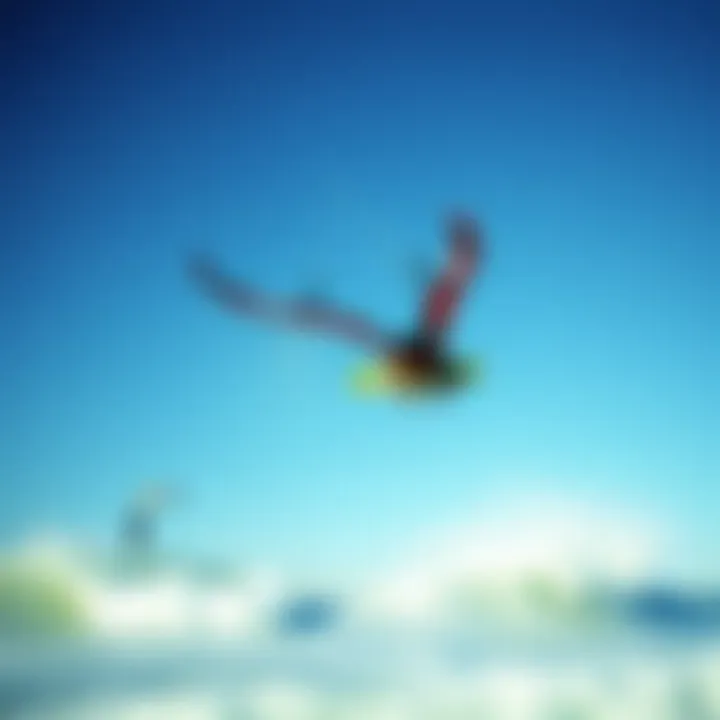
"Perfecting transitions takes practice, but once you feel it, it’s like dancing on the water."
Mastering transitions allows you to link various maneuvers together seamlessly. It serves as a foundation for more complex tricks, all while keeping your ride smooth and controlled.
Jumping and Tricks
As riders become more comfortable handling their wings and boards, they often seek the thrill that jumping brings. Jumping is not just about lift; it's about timing, technique, and understanding how to use the wind to your advantage. Developing a solid jump technique can enhance your riding style and add an exhilarating aspect to your sessions.
Key Techniques for Successful Jumps:
- Timing your takeoff: You need to synchronize your pop with a gust of wind. To do this, keep an eye on the wind speed and direction.
- Crouch and explode upward: Bend your knees to generate power in your legs. Then, spring up quickly while pulling on the wing. This motion creates lift and helps you launch.
- Wing position: After takeoff, the wing should be angled above you, helping to keep you stable in air.
- Landing: Focus on keeping your knees soft when you hit the water. A gentle landing is vital to reduce impact and maintain balance.
As you develop this skill, you can incorporate tricks such as grabs or spins that add flair to your jumps. Always be mindful of safety and control, ensuring you’re within your abilities before attempting advanced tricks.
Engaging in jumping and advanced maneuvers transforms your wing kitesurfing practice, allowing for self-expression and personal growth within this exhilarating sport.
Choosing Ideal Locations
Selecting the right location for wing kitesurfing is like choosing the perfect canvas for a masterpiece. It can make all the difference in one’s experience and skill development. Whether you're just starting or looking to refine your techniques, the location you pick will influence not only your performance but also your enjoyment of the sport.
Factors Influencing Location Selection
When it comes to finding the perfect spot to catch some wind and ride the waves, several key factors come into play:
- Wind Conditions: First and foremost, consistent wind is crucial. Ideally, you want steady, clean wind that blows at a speed suitable for your current skill level. Some areas may have shifting gusts that can be tricky for beginners, while more experienced riders could thrive in such conditions.
- Water Quality: Look for locations that have clean, safe water. Shallow lagoons can offer a gentler environment for those just learning the ropes, while oceanic conditions might be more appealing to seasoned surfers. Be mindful of debris or hazards that could pose a risk.
- Weather Patterns: Understanding the local climate will help in planning your sessions. Some regions might be prone to seasonal winds, so it's wise to research what times of year offer the best conditions. Even a small fluctuation in weather can dramatically change the experience.
- Accessibility: Consider how easy it is to get to your chosen spot. Locations that are hard to reach can often be isolating, which might not be ideal for a fun day on the water. Adequate parking, amenities, and proximity to local conveniences can enhance the overall experience.
- Crowd Levels: Some enthusiasts prefer bustling beaches filled with fellow kiteboarders, while others might seek solitude. Picking a less crowded spot might offer more space and less distraction, especially for beginners looking to focus on their skills.
These factors combined will greatly influence how enjoyable and productive one's wing kitesurfing sessions can be. The right spot can turn an average day into a thrilling adventure.
Top Destinations for Wing Kitesurfing
There are places around the globe that are like gems waiting to be discovered by wing kitesurfers. Here are a few less common but exceptional destinations worth considering for your next session:
- La Ventana, Mexico: Known for its warm waters and consistent winds, La Ventana is a favorite among kitesurfers. You can enjoy the stunning backdrop of the Sierra de la Giganta mountains while catching air on turquoise waves.
- Cumbuco, Brazil: Cumbuco is a hotspot for kitesurfing, with its wide-open beaches and reliable wind conditions nearly year-round. It’s a place where both beginners and advanced riders can flourish in different wind conditions.
- Maui, Hawaii: Famous for its oceanic conditions, Maui offers an ambiance like no other. The combination of stunning landscapes and optimal wind creates a perfect playground for those looking to elevate their wing kitesurfing skills.
- Tarifa, Spain: Often referred to as the wind capital of Europe, Tarifa features spectacular beaches and a vibrant kitesurfing culture. It caters to riders of all levels with its diverse conditions.
- Hatteras Island, North Carolina: This location is famous for its shallow waters and steady winds, making it ideal for practitioners focused on mastering their skills. The community is welcoming and provides a laid-back vibe that many riders appreciate.
Environmental Considerations
Wing kitesurfing, while exhilarating, also brings forth crucial responsibilities towards the environment. The delicate balance of marine ecosystems must be acknowledged by all enthusiasts in the sport. As we glide over the waves, it’s essential to appreciate not just the thrill of the ride, but also the impact our actions may impose on the natural world surrounding us. Engaging in sustainable practices and understanding our influence on marine life can enhance not only our experience but also the health of the ecosystems we enjoy.
Impact on Marine Ecosystems
The effects of mankind’s activities on oceans and rivers can't be overstated. When wing kitesurfers frequent these waters, they unwittingly affect marine habitats. For instance, disturbances from our maneuvers can displace fish beds or cause stress to sensitive species. It's vital to be aware of these impacts, as thriving marine environments are crucial for biodiversity. Here are some key points to consider regarding our impact:
- Habitat Disruption: Each launch, landing, and agile turn can cause disturbances to plants and animals that call the underwater landscape home.
- Pollution Concerns: The materials in some wings and boards, if not disposed of properly, can contribute to the problem of marine debris, which many animals ingest, leading to health issues.
- Wildlife Interactions: While it’s tempting to get close to marine animals for an exciting experience or a photo, doing so can significantly disturb their natural behaviors, potentially affecting their survival.
"Every action in the water has a ripple effect on the life beneath the surface. Consider how your enjoyment could affect those who dwell below."
Sustainable Practices for Enthusiasts
Being a responsible kitesurfer isn't just about avoiding harm; it's also about actively contributing to the health of marine ecosystems. Implementing sustainable practices can create a positive cycle, making our beloved spots cleaner and safer for both enthusiasts and marine life. Some productive strategies include:
- Educate Yourself and Others: Stay informed about local wildlife and ecosystems. Share this knowledge with your fellow kitesurfers. Knowledge can foster greater respect for the water.
- Clean Up Initiatives: Participate in or organize beach clean-up events. There’s nothing like turning a fun day into a contributing one for the environment while creating camaraderie among peers.
- Choose Eco-Friendly Gear: Opt for sustainable brands that minimize environmental impact through their production processes. Research the materials and sourcing of your equipment to ensure it aligns with eco-conscious practices.
- Respect Wildlife: Observe local guidelines regarding wildlife. Maintain a safe distance from nests or breeding areas.
In the vibrant community of wing kitesurfers, establishing and adhering to these practices can foster a culture of environmental stewardship. Let’s treat the waters with the respect they deserve, preserving the wonder of wing kitesurfing for generations to come. For more information on marine conservation, you can explore resources at The Ocean Conservancy or check out guidelines from your local wildlife agency.
Safety Protocols in Wing Kitesurfing
In the realm of wing kitesurfing, safety isn’t just an afterthought; it’s the bedrock on which enjoyable and adventurous experiences are built. This sport combines the raw forces of nature with human skill, making it imperative to approach each session with a vigilant mindset. The importance of safety protocols cannot be overstated. They not only protect participants from potential mishaps but also ensure that everyone around them enjoys the day without any unwarranted dramas. By embedding robust safety measures into each session, riders can focus on honing their skills and exploring the exhilarating waters without the looming specter of danger.
Pre-Session Safety Checks
Before you dip your toes into the water, there are essential checks to run through:
- Gear Inspection: Every piece of equipment should be in tip-top shape. Before heading out, inspect the wing for any tears or damage and ensure that all lines are untangled and aligned properly. The board should also be free from cracks or other significant wear. Without going through these motions, a sudden gust or miscalculation could lead to serious trouble.
- Wind and Weather Conditions: Understanding the day’s forecast is crucial. If the winds are behaving like a wild teenager and exceeding your skill level, it’s best to wait it out. Check local conditions and be aware of any changes that could affect your session.
- Location Assessment: Familiarize yourself with the environment. Are there any hidden rocks or strong currents? Have a good mental map of the area. Knowing your surroundings can make the difference between a thrilling ride and a premature exit.
- Buddy System: Always ride with a partner. A friend nearby can serve as an anchor of safety, ready to assist if the unexpected happens. Plus, it adds an element of camaraderie that enhances the whole experience.
By conducting these checks, you set the stage for a safe and enjoyable day on the water.
"An ounce of prevention is worth a pound of cure."
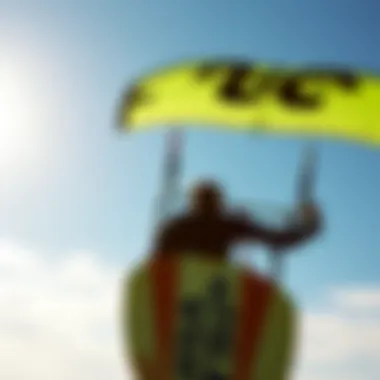
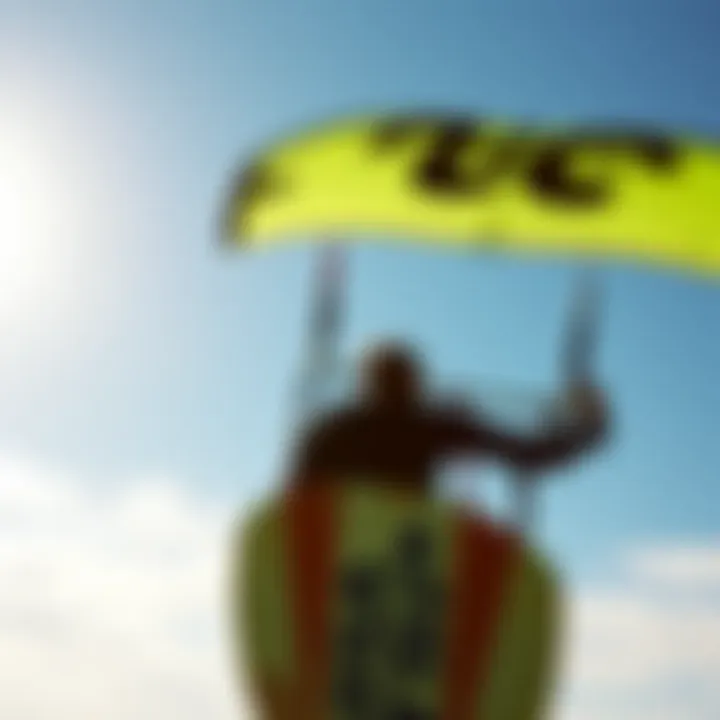
Emergency Procedures
Despite the best-laid plans, emergencies can arise. Being prepared for these scenarios is part and parcel of responsible kitesurfing. Here are fundamental steps to keep in mind:
- Know the Emergency Signals: Familiarize yourself with commonly accepted emergency signals, both verbal and visual. A simple shout for help might not suffice in windy conditions, so hand signals can be crucial.
- Isolation Protocol: If you find yourself in a precarious situation, such as getting caught in strong winds or currents, try to isolate yourself. Stay calm, brace yourself, and assess the surroundings before making any moves.
- Use Safety Gear: Always have a whistle or a signaling device on you. A lightweight floatation device can go a long way if you end up separated from your board and are in deep water. These items should form part of your standard gear for every outing.
- Rescue Procedures: Establish a clear rescue plan with your riding buddy before you hit the waves. If someone is in distress, acting swiftly and decisively can save lives. Ensure both of you know how to perform a water rescue, including keeping a safe distance from any low-flying gear.
Being prepared for emergencies allows you to navigate the unpredictable waters of wing kitesurfing with confidence. As the saying goes, it’s better to know and not need it than to need it and not know.
Community and Collaboration
In the realm of wing kitesurfing, community and collaboration are not just buzzwords; they are the lifeblood of this thrilling sport. As enthusiasts embark on their journey, they quickly realize that sharing experiences and forging connections enhances skills and broadens horizons far beyond solo sessions. This aspect of the culture is critical, especially as wing kitesurfing continues to gain traction across various regions.
Joining Local Groups
Getting involved with local groups can significantly enhance one’s kitesurfing experience. Whether it's a casual meet-up at the beach or organized events that bring together seasoned veterans and newcomers alike, these gatherings pave the way for friendship and mentorship. Local groups often provide invaluable tips on everything from the best spots to common pitfalls, ensuring newer kiteboarders feel welcomed rather than overwhelmed.
Moreover, being part of a community allows individuals to keep their finger on the pulse of the latest happenings in wing kitesurfing, from gear releases to upcoming competitions. Here’s why gravitating towards local circles can be beneficial:
- Skill Development: Learning from others speeds up the process, especially when faced with complex maneuvers.
- Safety in Numbers: There’s safety in numbers, as having fellow riders nearby provides added security should anything go awry.
- Shared Resources: Many groups access shared equipment that newcomers may not yet own, allowing them to try different kites and boards without breaking the bank.
Connecting with organizations that emphasize communal sharing can be pivotal. Websites like Reddit often feature local subreddits where kiteboarders can find partners to ride with. Diving into social media platforms like Facebook can lead to various local groups, fostering a sense of belonging among enthusiasts.
Sharing Knowledge and Experiences
As the wind carries the kites across azure waters, so too do the stories and lessons learned throughout this exhilarating adventure. The importance of sharing knowledge and experiences cannot be overstated; it forms a vital component of community growth and individual enhancement in wing kitesurfing. Marrying experience with education creates a fertile ground for advancement in techniques, safety protocols, and environmental awareness.
Open discussions about techniques, challenges faced, and solutions encountered cultivate an environment where both novices and experts can thrive. Here’s how sharing can be advantageous:
- Improved Technique: By exchanging feedback on performance, riders can fine-tune their skills and minimize mistakes in the water.
- Inspiring Creativity: Understood limitations often breed innovation. Sharing ideas can lead to new tricks, styles, and approaches that may not have been previously considered.
- Building a Support Network: Experiences spoken aloud can resonate with others, creating bonds that last beyond the beach and into other sectors of life.
A significant platform where such exchanges occur is educational events, workshops, or competitions. Participants often share insights on their best practices. Online forums or workshops hosted on websites like Wikipedia or even community-led workshops can provide robust knowledge bases that benefit all skill levels.
Beyond the tangible techniques and advice, there’s an intrinsic value in camaraderie and support that comes from a united community. When kitesurfers band together, they foster an atmosphere that not only builds technical aptitude but also cultivates a shared love for the ocean, wind, and sport itself.
Having a strong community not only enriches the individual experience but uplifts the entire sport of wing kitesurfing, paving the way for future generations to thrive in an environment that values collaboration and communal growth.
Future Trends in Wing Kitesurfing
As wing kitesurfing grows, it’s essential to keep an eye on where the sport is heading. This segment helps enthusiasts and industry insiders catch the wind of change, understanding what innovations and shifts can shape their kitesurfing experience in the coming years. Being aware of trends is not just advantageous but crucial for staying ahead in a sport that merges adventure with technology.
Technological Innovations
The future of wing kitesurfing is significantly tied to advancements in technology. Here are a few key areas where innovation is making waves:
- Materials: Light yet durable materials are being used for wing construction, such as advanced polyurethanes and laminates. These materials not only enhance performance by improving lift but also increase longevity, allowing kite surfers to shred waves without a worry.
- Wings Designs: New designs are emerging that improve controllability and reduce drag. This includes more refined wing shapes that allow riders to capture better wind efficiency while also enabling smoother transitions.
- Smart Features: Integration of smart technology into wing kitesurfing gear is a trend gaining traction. Sensors can now monitor wind conditions and provide real-time feedback about performance metrics like speed and distance traveled.
These innovations open the door to a more intuitive and seamless kitesurfing experience. The accessibility that comes from such technological breakthroughs may attract a wider audience, making the sport more inclusive.
Evolving Community Dynamics
The community surrounding wing kitesurfing is evolving alongside the equipment and techniques. Here’ some aspects deserving attention:
- Online Platforms: The growth of social media and online forums is pivotal. Platforms like Reddit and specialized Facebook groups are turning into hubs for discussions, tips, and sharing experiences. The sense of camaraderie is strong as enthusiasts connect and support each other.
- Event Collaboration: More local and international competitions are fostering connection. Events allow kitesurfers to gather, showcasing skills while also sharing knowledge of local spots and techniques. Through collaboration, the community grows stronger.
- Inclusive Practices: There’s a noticeable shift toward inclusivity in the kitesurfing community. Newer riders and diverse groups are getting encouraged to take part in the sport, breaking the stereotype that this is just an elite activity for a select few.
"The kiteboarding community is more than just a hobby; it’s a tapestry of experiences woven together by shared excitement and brotherhood."
These emerging dynamics signal a bright future, where a wider variety of individuals can experience the thrill of wing kitesurfing while maintaining the sport’s integrity.
In summary, being aware of technological advancements and community changes can provide kitesurfing enthusiasts with more than just a surface-level understanding—it creates a foundation that supports continual growth in skill and camaraderie. Keep this in mind as you hop on your board and take to the water.
Epilogue
In wrapping up the conversation surrounding wing kitesurfing, it's crucial to highlight the multifaceted nature of this exhilarating sport. The discussion we’ve had points to not just the sheer thrill of riding the waves under the canopy of a wing, but also to the significant community, ecological, and skill development aspects that are integral to the practice.
Summarizing Key Takeaways
First and foremost, wing kitesurfing is a unique blend of varied elements that caters to a spectrum of enthusiasts. Throughout the article, we've seen how essential gear—like wings, boards, and safety equipment—can greatly enhance the water experience. Beyond gear, learning the right techniques, from the basics for beginners to the more advanced tricks aimed at seasoned riders, sets a clear path toward progression.
Another element worth emphasizing is the importance of environmental considerations which go hand-in-hand with the sport. As individuals who thrive on these natural settings, it's our responsibility to engage in sustainable practices. Knowledge sharing and community cohesion were also underscored, reinforcing the notion that we grow strongest when we combine our experiences and support each other in this passionately growing niche of kitesurfing.
Remember, the more you immerse yourself into the nitty-gritty of wing kitesurfing, the more rewarding the experience becomes.
Encouragement for Continued Learning
As we conclude, there's an inherent encouragement to stay curious. Whether it's diving into new techniques, exploring diverse locations, or understanding the ecological impacts of our actions, each facet contributes to being not just a better kitesurfer, but a more responsible adventurer. The sport is continuously evolving; technologies are advancing, new tricks are being developed, and locations wait to be discovered. Therefore, engaging with local communities, participating in workshops, and staying updated through credible resources can enhance your skills and broaden your horizons.
To stay connected, consider following reputable kitesurfing forums, joining local groups on platforms like reddit.com or social media channels, and keeping an eye on informative sites such as www.britannica.com or the Kiteboarding Association website (kiteboarding.com), where one can find a treasure trove of resources.
In essence, the journey in wing kitesurfing is personal yet collective, and there’s always something new to grasp. Let the waves and winds guide you towards greater heights, literally and figuratively.
